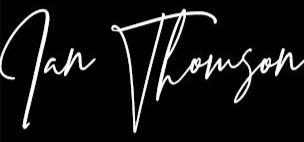
19 Mar Archetypes, Prehistoric Personalities in a New Context?
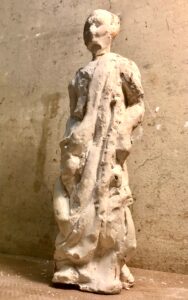
I have been working on a new theme based on Jungian archetypes.
Jungian archetypes and the collective unconscious are intriguing ideas that appear to link many elements in diverse fields such as psychology, philosophy, religion and culture. They provide a fertile base for numerous lines of enquiry.
Carl Jung, associate of Sigmund Freud, used the word archetype to describe human characteristics that reoccur throughout all cultures, races and continents. They form part of the unconscious mind. Furthermore, he (unlike Freud) went on to assert that there is a collective unconscious comprised of these archetypes.
Jung’s conception of archetypes, which is based upon Schopenhauer’s prototypes and Plato’s Forms, is hard to pin down as he claims there are potentially an unlimited number and the influence they have in our day to day lives may vary over time. Furthermore, an archetype always contains its opposite. Modern psychology has organised the main archetypes into twelve: artist, explorer, rebel, lover, innocent, everyman, hero, caregiver, jester, sage, magician and ruler. The first four being aspects of the soul, the next four are aspects of the ego and the last four aspects of the self.
Jung stated that individuation (what we might perhaps call flourishing or well-being and perhaps what Buddhists would call enlightenment) occurs when we firstly recognise which qualities we have, which are dominant and which are underdeveloped and then secondly, when we accept our shadow or the negative aspects of our archetypes.
Every archetype contains its opposite, for example the Anima (female) also contains the Animus (the male) and visa versa. I believe this is why the Hindus interpretation of The Divine involves multiple gods where Brahmin the creator and Shiva the destroyer are part of one and the same phenomenon. Saying that you cannot have creation without first there being destruction sometimes indicates this.
The Old Testament God, who is so puzzling and contradictory to our modern eyes, also contains something of this paradox. In the light of Jesus’ teachings of a compassionate, loving, parental god it would be tempting to of write off sections of scripture as being erroneous or out-dated. However, if God can somehow contain both good and bad as the Hindus tell us, the Old Testament makes a little more sense.
There are many scenarios where what we perceive as bad could be for the greater good. We will never have the ability to process infinite scenarios. God presumably has. Our perception of good and bad is extremely limited and when we perceive things to be both good and bad, that is just how it is. That is how the universe works.
I am interested in archetypes because they seem to be a modern “take” on Plato’s Forms, which in my opinion are aspects of The Divine. I have used the twelve modern versions of the archetypes, as they are clearer than Jung’s originals. However, I would say that Jung’s conception is necessarily complicated and nebulous since, if any real understanding of The Divine is possible intellectually, it is bound also to be complicated and nebulous.
This vagueness, while a problem to the rational mind, may be an advantage artistically. Artists work intuitively and if I have immersed myself in the subject, as I have attempted to do, the work I produce should contain ambiguities that better reflect the nature of an archetype. An ambiguous figurative sculpture can be well suited to this end as can abstract sculpture.
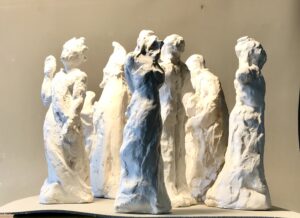
I have produced twelve human figures representing the twelve archetypes and grouped them into the three groups, ego, self and soul, to be displayed in a casual group as if wandering through empty space. I have tried to avoid literal representations of the themes but some figures, where the character of the archetype seems very strong, are less subtle than others. I believe I have also avoided some of the more obvious gender stereotypes. My sources of inspiration include Rodin, Manzu and Donatello.
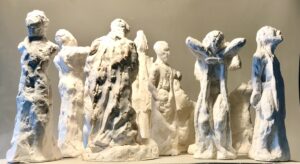
Working in parallel I have been producing abstract sculptures not always with a specific archetype in mind but with my attention focused in that direction, which I’m hoping will produce something randomly fresh but still connected on some level.
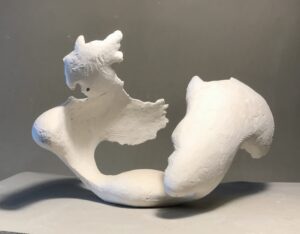
“Jung believed that the unconscious is not merely the hiding place of demons but the province of angels and ministers of grace, which he called the archetypes…symbols of all the inner forces that work toward unity, health, fullness of life and purposeful conscious development.” (C. Mumford, The New Yorker)

